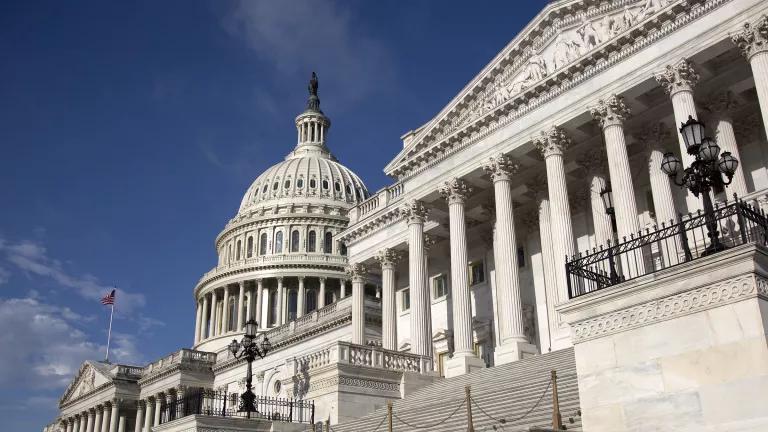Biden's Defense of Nature Protects Climate and Biodiversity
Biden's promise to protect 30% of terrestrial and marine ecosystems by 2030 is a critical part of a strategy to stop climate change, prevent species collapse and enhance the resiliency of our natural world and the communities that rely on it.

Boreal forest in Alaska
As a candidate, President-elect Biden connected the dots between the stress climate change is placing on species and ecosystems and the need to fight species collapse and protect our natural ecosystems’ capacity to store carbon as part of our response to the climate crisis. The campaign pledged to move “further, faster and more aggressively than ever,” on those fronts, specifically by “protecting biodiversity, slowing extinction rates and helping leverage natural climate solutions by conserving 30 percent of America’s lands and waters by 2030.”
These are complementary goals.
Rainforests, forests, wetlands and mangroves are powerful natural allies in the climate fight because they absorb carbon from the atmosphere and lock it up in healthy soils. For instance, our global forests absorb nearly a third of all greenhouse gas emissions each year and lock away nearly twice as much carbon as is in all global coal, oil and gas reserves. Additionally, these areas can help make communities safer from the effects of climate change, by acting as buffers against sea level rise and flooding. Protecting, conserving and strengthening these natural systems is therefore essential to fighting and managing climate change.
Just as clearly, warming temperatures, rising seas, wildfires and other hallmarks of climate change are inflicting grave damage and mounting danger on these systems and the wildlife they support—from the tiniest insect to the largest whale. With roughly one million plant and animal species facing the prospect of near-term extinction, protecting the world’s natural systems—on which we depend for our health, food security, and quality of life—from and helping them adapt to the growing stresses of climate change is vital to an effective response.

A kelp forest off the coast of La Jolla, California.
The incoming Biden Administration should hit the ground running on maximizing nature’s value to fight and resist climate change. On day one, President-elect Biden should fulfill his pledge to put America on the path of protecting 30% of its lands and waters and oceans by 2030 through an Executive Order that adopts this 30x30 goal and creates a Task Force to develop an action plan that agencies (with key roles for the Departments of the Interior and State, as well as the National Oceanic and Atmospheric Administration and the U.S. Forest Service) can implement to protect important areas of America’s natural heritage. Multiple federal agencies, states, Tribes, and local and affected stakeholder communities, along with our international neighbors, need to be able to meaningfully participate in the plan’s development. And, to ensure that the United States can meet the target through robust protections of ecologically representative areas within nine years, the work must get off the ground immediately, with the plan completed roughly a year after the order is issued.
One of the most effective ways to protect biodiverse and carbon rich ecosystems is to follow the leadership of Indigenous Peoples, who have safely stewarded their traditional territory for millennia. Time and again, reports have shown that where Indigenous rights to their land are strong, both climate and biodiversity are better protected. President-elect Biden has signaled he intends to take this approach in the U.S. 30x30 strategy with his commitment to support Indigenous sovereignty, to work with tribal governments to protect sacred sites and public lands and waters with high conservation and cultural values, and provide a greater role in the care and management of public lands that are of cultural significance to Tribal Nations.
Protecting ecosystems that naturally fight climate change by sequestering and storing carbon for centuries, should necessarily be among the ecosystems protected as part of a 30x30 commitment as they also tend to be rich in biodiversity and provide invaluable ecosystem services.
Unfortunately, many governments ignore or undercount the emissions associated with logging and other industrial activities in forests and other carbon rich ecosystems, which undermines efforts to reduce a significant source of emissions. The Biden campaign’s plan to work with regional partners in the Americas to establish a “framework to limit greenhouse gas emissions related to land use, forests and agriculture” will support both U.S. and international efforts to identify and protect the ecosystems that have the greatest potential to support the world’s climate goals.
This commitment to 30x30 must also be backed up by a robust application of current laws. That’s why securing the protection and resiliency of significant ecosystems will require the Biden Administration to take action to reestablish environmental safeguards, including the Clean Water Act’s protections on our nation’s waters and wetlands and the Endangered Species Act’s protections of our most imperiled species. These protections, rolled back by the Trump Administration, play a central role in safeguarding our waterways and wetlands from oil, mining and other industrial waste, and our wildlife from habitat loss, pollution, and climate change.
The Biden Administration also has an opportunity to leverage the benefits of 30x30 by working with Canada, which also committed to 30x30 and shares many of North America’s migratory species with the United States, to support the conservation of large, ecologically rich landscapes across our borders and coordinate on the protection of key terrestrial and marine migratory routes and habitats. And, the Administration can work with leaders around the world to use its diplomatic influence and development cooperation to set and achieve a global goal to fully and highly protect at least 30% of the global ocean and 30% of global land and inland waters by 2030.
Given the scale and scope of the challenges we face, 30x30 is a down payment on a new relationship with nature that we must make to keep our global life support system in operation. Only by dedicating more areas to the purpose of their natural character—vibrant ecosystems thriving with abundant wildlife—will we ensure clean water, clean air, healthy communities, secure food supplies, and a stable climate for future generations.





